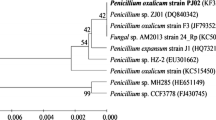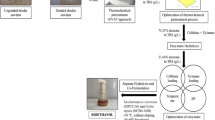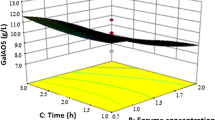Abstract
This study investigated the optimum conditions, including pH, temperature, incubation time, and enzyme concentration, for the enzymatic manufacture of citron waste juice by pectinase and cellulase using response surface methodology (RSM). A central composite design was used as an experimental design for the allocation of treatment combination. The highest yield was 71.1% at pH 5.00, 51.15°C, 53.74 min, and 0.44%, whereas the lowest turbidity was 0.20 at pH 4.87, 50.21°C, 49.99 min, and 0.44%. The highest hunter’s L (lightness), a (redness), and b- (yellowness) values were 47.39 (pH 4.86, 50.72°C, 51.60 min, and 0.44%), −1.34 (pH 5.48, 49.36°C, 46.29 min, and 0.21%), and 13.18 (pH 5.49, 50.05°C, 43.31 min, and 0.23%), respectively. The highest electron donating activity was 68.36% at pH 4.51, 50.62°C, 47.00 min, and 0.23%. The highest limonin and nomilin contents were 3.49 mg/100 g (pH 4.51, 50.30°C, 48.34 min, and 0.21%) and 1.56 mg/100 g (pH 4.59, 50.08°C, 66.07 min, and 0.30%).
Similar content being viewed by others
References
Asadi Abkenar A, Isshiki S. Molecular characterization and genetic diversity among Japanese acid citrus (Citrus spp.) based on RAPD markers. J. Hortic. Sci. Biotech. 78: 108–112 (2003)
Sawamura M, Sun SH, Ozaki K, Ishikawa J, Ukeda H. Inhibitory effects of citrus essential oils and their components on the formation of N-nitrosodimethylamine. J. Agr. Food Chem. 47: 4868–4872 (1999)
Choi IW, Choi SY, Nam BR, Kim YS, Choi HD. Contents of polyphenols and limonoids in citron (Citrus junos Sieb. Ex Tanaka) seed extracts and their antioxidant properties. Food Sci. Biotechnol. 17: 373–378 (2008)
Kato-noguchi H, Tanaka Y. Allelopathic potential of Citrus junos fruit waste from food processing industry. Bioresource Technol. 94: 211–214 (2004)
Abdullah AGL, Sulaiman NM, Aroua MK, Noor MJMM. Response surface optimization of conditions for clarification of carambola fruit juice using a commercial enzyme. J. Food Eng. 81: 65–71 (2007)
Kaul A, Khanduja KL. Polyphenols inhibit promotional phase of tumorigenisis relevance of superoxide radicals. Nutr. Cancer. 32: 81–85 (1998)
Puupponen-pimia R, Nohyek L, Meier C, Kahkonen M, Heinonen M, Hopia A, Oksman-cladentey KM. Antimicrobial properties of phenolic compounds from berries. J Appl. Microbiol. 90: 494–507 (2001)
Faigh JG. Enzyme formulations for optimizing juice yields. Food Technol. -Chicago 9: 79–83 (1995)
Lea AGH. Enzymes in the production of beverages and fruit juices. pp. 221–249. In: Enzymes in Food Processing. Tucker GA, Woods LFJ (eds). Blackie Academic and Professional Ltd., Glasgow, UK (1995)
Mouri T, Kayama H. Cellulase treatment of orange material. US Patent 4,299,849 (1981)
Myers R, Montgomery DC. Response Surface Methodology: Process and Product Optimization Using Designed Experiments. Wiley, New York, NY, USA. pp. 364–370 (2002)
Jeong YJ, Lee GD, Lee MH, Yea MJ, Lee GH, Choi SY. Monitoring on pectinase treatment conditions for clarification of persimmon vinegar. J. Korean Soc. Food Sci. Nutr. 28: 810–815 (1999)
Choi JS, Hwang JK, Kim CT, Chung KH, Lee KS. Enzymatic solubilization of thermally treated jujube tissues. Korean J. Diet. Culture 11: 683–687 (1996)
Blois MS. Antioxidant determination by the use of a stable free radical. Nature 26: 1199–1204 (1958)
Jeong JY, Woo KS, Hwang IG, Lee YR, Pack ES, Jeong HS. Optimization of extraction conditions for limonin and nomilin in citron seed. Korean J. Food Sci. Technol. 40: 540–544 (2008)
Joshi VK, Chauhan SK, Lal BB. Extraction of juices from peaches, plums, and apricots by pectinolytic treatment. J. Food Sci. Technol. 28: 64–65 (1991)
Suad N, Al-Hooti, Jiwan S, Sidhu, Jameela M, Al-Saqer, Amani Al- Othman. Chemical composition and quality of date syrup as affected by pectinase/cellulase enzyme treatment. Food Chem. 79: 215–220 (2002)
Isabella MB, Geraldo AM, Raimundo WF. Physical-chemical changes during extraction and clarification of guava juice. Food Chem. 54: 383–386 (1995)
Sohn KS, Lee JH, Ha YS. Clarification of mixed fruit and vegetable juice using enzyme treatment. Food Eng. Progress 6: 241–247 (2002)
Albarez S, Alvarez R, Riera FA, Coca J. Influence of depectinization on apple juice ultrafiltration. Colloids Surfaces A 138: 377–382 (1998)
Brimelow CJB, Groesbeck CA. Color measurement of foods by color reflectance instrumentation. pp. 63–69. In: Instrumentation and Sensors for the Food Industry. Kress-Rogers E (eds). Butterworth Heinemann Ltd., Oxford, UK (1993)
Lim HK, Yoo ES, Moon JY, Jeon YJ, Cho SK. Antioxidant activity of extracts from dangyuja (Citrus grandis Osbeck) fruits produced in Jeju island. Food Sci Biotechnol. 15: 312–316 (2006)
Woo KS, Jeong JY, Hwang IK, Lee YJ, Lee YR, Pack HJ, Park ES, Jeong HS. Antioxidant activity of ethanol extraction on citron seed by response surface methodology. J. Korean Soc. Food Sci. Nutr. 38: 384–390 (2009)
Lee MH, Huh D, Jo DJ, Lee GD, Yoon SR. Flavonoids components and functional properties of citrus peel hydrolysate. J. Korean Soc. Food Sci. Nutr. 36: 1358–1364 (2007)
Manners GD, Hasegawa S, Bennett RD, Wong RY. LC-MS and NMR techniques for the analysis and characterization of Citrus limonoids. Vol. 758, pp. 40–59. In: Citrus Limonoids: Functional Chemicals in Agriculture and Foods. Berhow MA, Hasegawa S, Manners GD (eds). ACS, Washington, DC, USA (2000)
Boo KH, Kim HN, Riu KZ, Kim YW, Cho MJ, Kim SM. Analysis of the limonoid contents of dangyuja (Citrus spp.) by liquid chromatography-mass spectrometry (LC-MS). J. Korean Soc. Appl. Biol. Chem. 50: 238–243 (2007)
Author information
Authors and Affiliations
Corresponding author
Rights and permissions
About this article
Cite this article
Lim, J.Y., Yoon, HS., Kim, KY. et al. Optimum conditions for the enzymatic hydrolysis of citron waste juice using response surface methodology (RSM). Food Sci Biotechnol 19, 1135–1142 (2010). https://doi.org/10.1007/s10068-010-0162-3
Received:
Revised:
Accepted:
Published:
Issue Date:
DOI: https://doi.org/10.1007/s10068-010-0162-3




